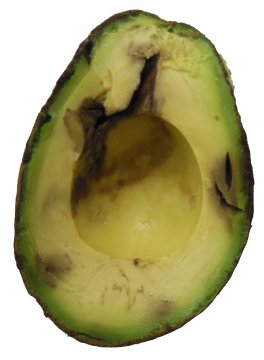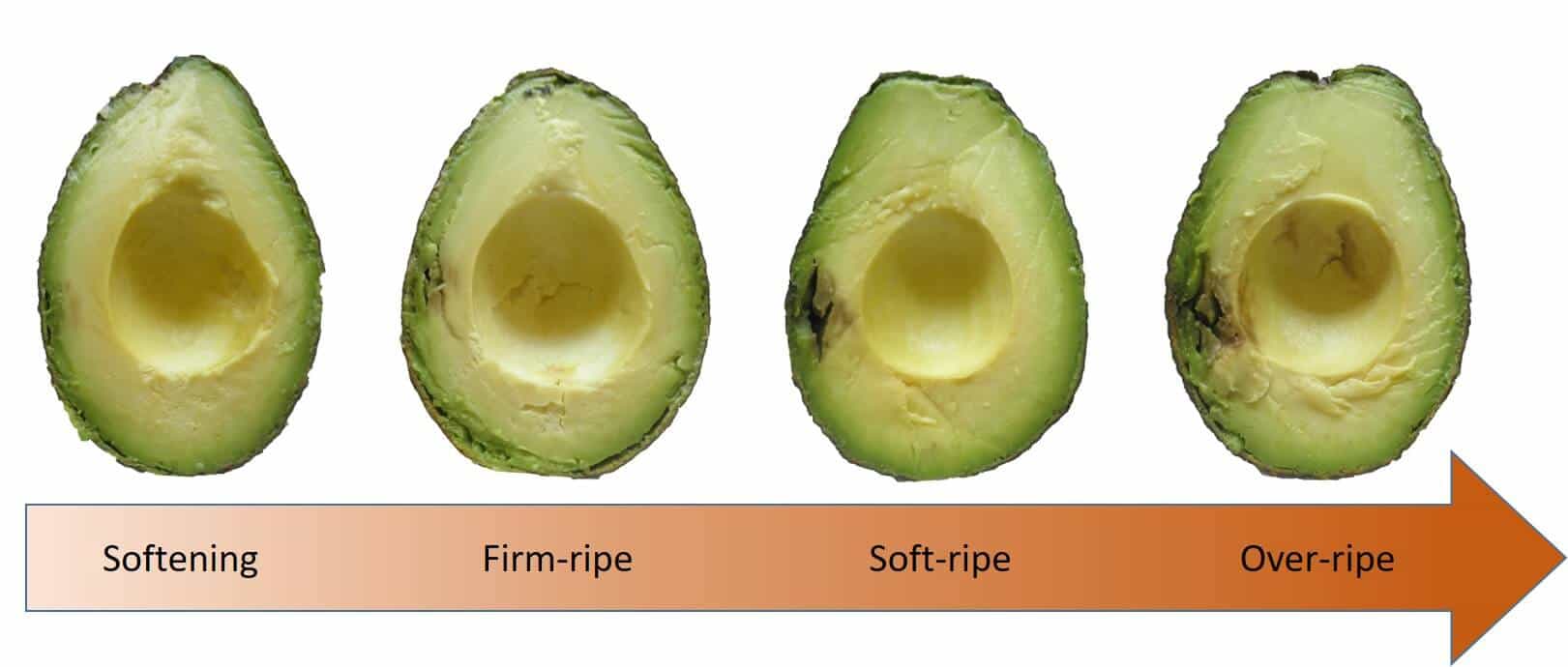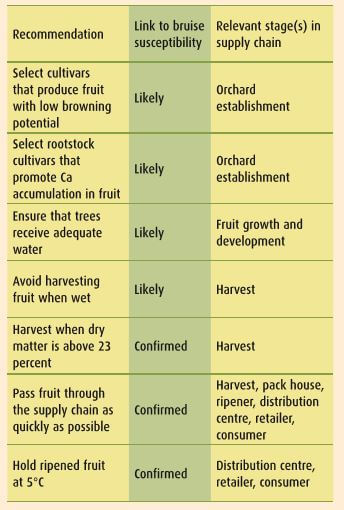Factors affecting avocado flesh bruising susceptibility
This article appears in the Winter 2017 edition of Talking Avocados (Volume 28 No 2).
Factors affecting avocado flesh bruising susceptibility
By Melinda Perkins, Muhammad Mazhar, Daryl Joyce, Noel Ainsworth, Lindy Coates and Peter Hofman
Avocados are prone to flesh bruising, especially once they reach retail shelves (Figure 1). This issue is a major concern to the Australian avocado industry, with flesh bruising being responsible for around half of all avocado internal defects detected at the retail level1. A problem for shoppers is that they can’t tell if a fruit is bruised internally until they cut it open at home. The end result in many cases is consumer disappointment and a reluctance to purchase avocados in the future2.
What is it that makes avocados susceptible to bruising and can anything be done to make them more resilient? Mechanisms involved in avocado flesh bruising and factors that govern them are discussed here with a view to reducing bruising.

What is bruising?
Physical injury of avocado fruit tissues occurs in response to applied mechanical force. Damage that leads to bruise expression is caused by impact (e.g. dropping), compression (e.g. squeezing) and/or vibration (e.g. transport) injuries. The walls of cells comprising fruit tissue are elastic to a limited degree. As such, they can absorb some of the physical shock without permanent injury being caused. However, when cells experience stress beyond their elastic limit, the cell walls fail and permanent damage occurs. In this circumstance, cell contents previously separated within compartments in the cell will mix together as the cells rupture. This brings phenolic compounds into contact with the enzyme polyphenoloxidase (PPO), which triggers enzymatic browning resulting in polymerised phenolics. These are brown in colour and are responsible for the typical dark discoloration recognised visually as a bruise.
How is bruising measured?
Flesh bruising in fruit has been described and measured in various ways3. Bruise incidence can be defined as the number of bruised fruit in a given sample (e.g. tray) of fruit. It can be expressed as a percentage of the total number of fruit affected within the sample. Alternatively, it can be measured and expressed as the number of bruises on any individual fruit. Bruise incidence data do not indicate the degree to which fruit are bruised. Bruise severity, on the other hand, indicates the size of a bruise. It is generally quantified as either the area or the volume of the affected flesh in individual fruit. The value may also be converted to a percentage of the total fruit flesh area or volume. The avocado industry recognises the importance of both bruise incidence and severity, and tracks the percentage of fruit at retail with more than 10 percent affected flesh area1 (the level generally considered to be unacceptable to consumers2). Bruise intensity is a measure of the relative darkness of a bruise. It can be scored visually (e.g. light brown to black) or measured with a colour meter. The latter involves recording three colour coordinate values (e.g. L, a, b) that pinpoint a particular colour in a three-dimensional colour space of all possible colours4. Bruise susceptibility is the relative degree to which a fruit bruises when given a specific damaging pressure. It is expressed as the amount of flesh showing damage per unit of absorbed impact or compression energy.
What affects bruise susceptibility?
Anecdotal and experimental evidence suggest that the susceptibility of avocados to bruising is related to fruit firmness, dry matter content, flesh temperature, and time in the supply chain.
Firmness is an indicator of cell wall strength in fruit tissue and a way to determine the ripeness of avocado fruit. Firmness decreases during ripening and has been characterised into the stages of hard, rubbery, sprung, softening, firm-ripe, soft-ripe, overripe, and very overripe5. Bruise susceptibility increases as firmness decreases. For example, injury due to a “very slight” thumb compression of 5 Newtons produced twice as much bruising (in terms of bruise area) in soft-ripe than firm-ripe Hass avocados (unpublished data; Figure 2). For impact injury, the drop height at which Hass avocados began exhibiting bruising was 5cm for sprung fruit and 2.5cm for firm-ripe fruit6. Mathematical modelling for Collison avocados suggested that the critical drop height for bruising was approximately 3cm in fruit that the authors referred to as “ripe”7. In contrast, hard fruit are resistant to bruising. No permanent bruising was recorded for hard green mature Hass avocados after impact from a drop height of 100cm. Initially damaged tissue in green mature fruit was apparently able to recover over time8.

Dry matter content tends to increase over the harvest season and is a reliable measure of avocado maturity. Fruit with higher dry matter were less susceptible to bruising in a study that subjected firm-ripe Hass avocados to a 50cm drop height8. Bruise volume progressively decreased as dry matter increased from 22 to 33 percent.
Relatively high fruit dry matter can offer consumers a better eating experience2. On the other hand, waiting to harvest unusually high dry matter avocados might lead to a less desirable eating experience. For example, a slight decline in consumers’ intentions to purchase avocados was observed when dry matter exceeded 40 percent2. Furthermore, a very late harvest may deplete carbohydrate reserves in the tree and increase the risk of biennial bearing9. Delaying harvest to ‘meet and beat’ the minimum recommended dry matter level for harvest (i.e. 23 percent+ for Hass) is likely to be a good compromise towards reduced bruise susceptibility.
The temperature of the fruit following an impact is a potentially important factor in lessening avocado flesh bruising. Hass avocados held at 5°C for 48 hours after being impacted did not show bruising8. In contrast, holding impacted fruit at 15 or 25°C for the same period resulted in 90 and 95percent bruise incidence, respectively. Moreover, bruise intensity was higher (i.e. darker) in fruit held at 25°C than at 15°C. The data suggested that flesh temperature during the first eight hours after impact is critical in determining visible bruising. Relatively greater PPO activity was considered to be the likely cause for greater bruise incidence observed at higher temperatures. Note, however, that chilling injury may occur in Hass avocados at 3°C or lower. Also, refrigeration of fruit at retail level may have cost and other marketing considerations.
Prolonged time in the system has been shown to increase the susceptibility of Hass avocados to bruising. When subjected to impact at the firm ripe stage, fruit stored at 5°C for one to five weeks prior to ripening tend to exhibit greater bruise volumes than un-stored control fruit8. A trend of increasing bruise volume was observed with increasing cold storage duration.
Any other factors?
Although not specifically researched to date, other factors are likely to affect bruising susceptibility by influencing the physical properties of cell walls and/or enzymatic browning processes.
Pre-harvest water stress has, for example, been found to promote PPO activity in avocado fruit10. Therefore, it might be reasonable to expect bruise expression to be greater in water deficit stress affected fruit. However, investigation is required to establish if this is the case.
Cultivar (i.e. genotype) is known to dictate the enzymatic browning potential of avocado fruit. For instance, the rate of cut flesh browning, as well as flesh total phenolic content and PPO activity, are greater in Fuerte than in Lerman11,12. For cultivars common in Australia, the peel of Hass avocados contains greater concentrations and diversity of phenolic compounds than does Shepard avocado peel13. The concentration of epicatechin, a known PPO substrate, exhibited a dramatic decrease in Hass avocados during a harvest season14. This trend may at least partly explain the decreasing bruise volumes observed with increasing dry matter over time as noted above.
Choice of rootstock cultivar has been shown to affect calcium (Ca) accumulation in avocado fruit. Ca is important for cell wall strength and membrane stability. Compared to fruit containing low Ca concentrations, Hass avocados with relatively high flesh concentrations at harvest show delayed ripening15,16, greater firmness after storage17, lower incidence and severity of body rots15,18, decreased mesocarp discolouration15,19, and reduced incidence and severity of vascular browning19,20. Grafting of Hass onto Velvick or A10 rootstocks produced fruit with high Ca concentrations21. However, variation in rootstock effects on postharvest fruit quality has been reported across different locations and seasons. Therefore, it is difficult to predict and remains to be proved which rootstock, if any, may reduce fruit susceptibility to flesh bruising.
High turgor pressure in flesh tissue has been linked to greater bruise susceptibility in fruits such as apple and pear22. However, no such studies have investigated the relationship between turgidity and bruising for avocado. Nonetheless, greater lenticel damage has been reported in avocado fruit with high cell turgidity23. It can be reasoned that, as turgor pressure rises, cell wall elasticity decreases and fruit tissues could become more ‘brittle’ and, therefore, susceptible to physical damage. Fruit that are wet from rainfall or dew are likely to have high turgor pressure. Harvesting fruit in wet conditions promotes vascular browning and lenticel damage in Hass avocados24,25.
Precautions to reduce bruise susceptibility
Based on the above, recommendations for improved practices to reduce bruise susceptibility in avocado fruit have been summarised in Table 1. For some recommendations, a confirmed link with bruising susceptibility was established in the recent Hort Innovation project, Reducing flesh bruising and skin spotting in Hass avocado (AV10019). On the other hand, some recommendations are based on anecdotal or indirect evidence. These, in particular, need to be further investigated for adoption or not into commercial practice.

Table 1. Practices known or likely to reduce susceptibility to flesh bruising in avocado.
Future work
Producing more resilient fruit is one approach to addressing the flesh bruising problem. Another is to minimise exposure of the fruit to damage events that cause bruising, such as dropping or squeezing. The ongoing Hort Innovation project Supply chain quality improvement – Technologies and practices to reduce bruising (AV15009) will also identify tools, practices and other measures for reducing damage events in the supply chain. All project AV15009 findings are being incorporated into the Avocados Australia online Best Practice Resource (www.avocado.org.au/best-practice-resource/) and shared with two concurrent avocado supply chain quality improvement projects, Cool chain best practice adoption (AV15010) and Retailer point of purchase improvements (AV15011).
Acknowledgement
The strategic levy investment Supply chain quality improvement – Technologies and practices to reduce bruising (AV15009) is a project under the Hort Innovation Avocado Fund, funded by Hort Innovation using the avocado research and development levy and contributions from the Australian Government. It is delivered by the Queensland Department of Agriculture and Fisheries in collaboration with The University of Queensland and Avocados Australia Ltd.
References
1. Tyas, J., 2016. Avocado industry fruit quality benchmarking. Final report AV11015. Horticulture Australia Ltd, Sydney.
2. Harker, F.R., Jaeger, S.R., Hofman, P., Bava, C., Thompson, M., Stubbings, B., White, A., Wohlers, M., Heffer, M., Lund, C., Woolf, A. 2007. Australian consumers’ perceptions and preferences for ‘Hass’ Avocado. Final report AV06025. Horticulture Australia Ltd, Sydney.
3. Opara, U.L., Pathare, P.B. 2014. Bruise damage measurement and analysis of fresh horticultural produce – A review. Postharvest Biology and Technology 91, 9-24.
4. Fairchild, M., 2013. Color appearance models. 3rd edition. Wiley, Sussex.
5. White, A., Woolf, A., Hofman, P.J., Arpaia, M.L., 2009. The international avocado quality manual. UC Davis Press, California.
6. Ledger, S.N., Barker, L.R., 1995. Black avocados – the inside story, Australian Avocado Growers Federation Conference – The Way Ahead, pp. 71-77.
7. Baryeh, E.A., 2000. Strength properties of avocado pear. Journal of Agricultural Engineering Research 76, 389-397.
8. Joyce, D.C., Mazhar, M.S., Hofman, P.J., 2015. Reducing flesh bruising and skin spotting in ‘Hass’ avocado. Final report AV10019. Horticulture Australia Ltd, Sydney.
9. Whiley, A.W., Rasmussen, T.S., Saranah, J.B., Wolstenholme, B.N., 1996. Delayed harvest effects on yield, fruit size and starch cycling in avocado (Persea americana Mill) in subtropical environments .2. The late-maturing cv Hass. Scientia Horticulturae 66, 35-49.
10. Bower, J.P., Cutting, J.G.M., Wolstenholme, B.N., 1989. Effect of pre- and post-harvest water stress on the potential for fruit quality defects in avocado (Persea americana Mill.). South African Journal of Plant and Soil 6, 219-222.
11. Golan, A., Kahn, V., Sadovski, A., 1977. Relationship between polyphenols and browning in avocado mesocarp. Comparison between the Fuerte and Lerman cultivars. Journal of Agricultural and Food Chemistry 25, 1253-1260.
12. Kahn, V., 1975. Polyphenol oxidase activity and browning of three avocado varieties. Journal of the Science of Food and Agriculture 26, 1319-1324.
13. Kosinska, A., Karamac, M., Estrella, I., Hernandez, T., Bartolome, B., Dykes, G.A., 2012. Phenolic compound profiles and antioxidant capacity of Persea americana Mill. peels and seeds of two varieties. Journal of Agricultural and Food Chemistry 60, 4613-4619.
14. Hurtado-Fernandez, E., Gonzalez-Fernandez, J.J., Hormaza, J.I., Bajoub, A., Fernandez-Gutierrez, A., Carrasco-Pancorbo, A., 2016. Targeted LC-MS approach to study the evolution over the harvesting season of six important metabolites in fruits from different avocado cultivars. Food Analytical Methods 9, 3479-3491.
15. Hofman, P.J., Vuthapanich, S., Whiley, A.W., Klieber, A., Simons, D.H., 2002. Tree yield and fruit minerals concentrations influence ‘Hass’ avocado fruit quality. Scientia Horticulturae 92, 113-123.
16. Witney, G.W., Hofman, P.J., Wolstenholme, B.N., 1990. Effect of cultivar, tree vigour and fruit position on calcium accumulation in avocado fruits. Scientia Horticulturae 44, 269-278.
17. Defilippi, B.G., Robledo, P., Ferreyra, R., Soto, S., Saavedra, J., 2015. Preharvest factors influencing ‘Hass’ avocado (Persea americana Mill.) quality during long term storage. Acta Horticulturae 1071, 137-141.
18. Everett, K.R., Boyd, L.M., Pak, H.A., Cutting, J.G.M., 2007. Calcium, fungicide sprays and canopy density influence postharvest rots of avocado. Australasian Plant Pathology 36, 22-31.
19. Marques, J.R., Hofman, P.J., Wearing, A.H., 2003. Rootstocks influence ‘Hass’ avocado fruit quality and fruit minerals. Journal of Horticultural Science & Biotechnology 78, 673-679.
20. Thorp, T., Hutching, D., Lowe, T., Marsh, K., 1997. Survey of fruit mineral concentrations and postharvest quality of New Zealand‐grown ‘Hass’ avocado (Persea americana Mill.). New Zealand Journal of Crop and Horticultural Science 25, 251-260.
21. Coates, L.M., Dann, E.K., Shuey, L.S., Smith, L.A., Dean, J.R., Cooke, A.W., Pegg, K.G., Hofman, P.J.,, Marques, R., Stubbings, B., Whiley, A.W., 2011. Effects of rootstock on avocado fruit quality – assessment of postharvest disease, major cations and biochemical traits. Proceedings of the 7th World Avocado Congress, 2011. Cairns, QLD, Australia, 206-214.
22. Garcia, J.L., Ruizaltisent, M., Barreiro, P., 1995. Factors influencing mechanical properties and bruise susceptibility of apples and pears. Journal of Agricultural Engineering Research 61, 11-17.
23. Everett, K.R., Hallett, I.C., Rees-George, J., Chynoweth, R.W., Pak, H.A., 2008. Avocado lenticel damage: The cause and the effect on fruit quality. Postharvest Biology and Technology 48, 383-390.
24. Duvenhage J., 1993. The influence of wet picking on post harvest diseases and disorders of avocado fruit. South African Avocado Growers’ Association Yearbook 16, 77-79.
25. Pak, H.A., Dixon, J., Smith, D.B., Elmsly, T.A., Cutting, J.G.M., 2003. Impact of rainfall prior to harvest on ripe fruit quality of ‘Hass’ avocados in New Zealand. Proceedings of the V World Avocado Congress, 2003, Granada -Málaga, Spain, 629-634.
Date Published: 28/07/2017